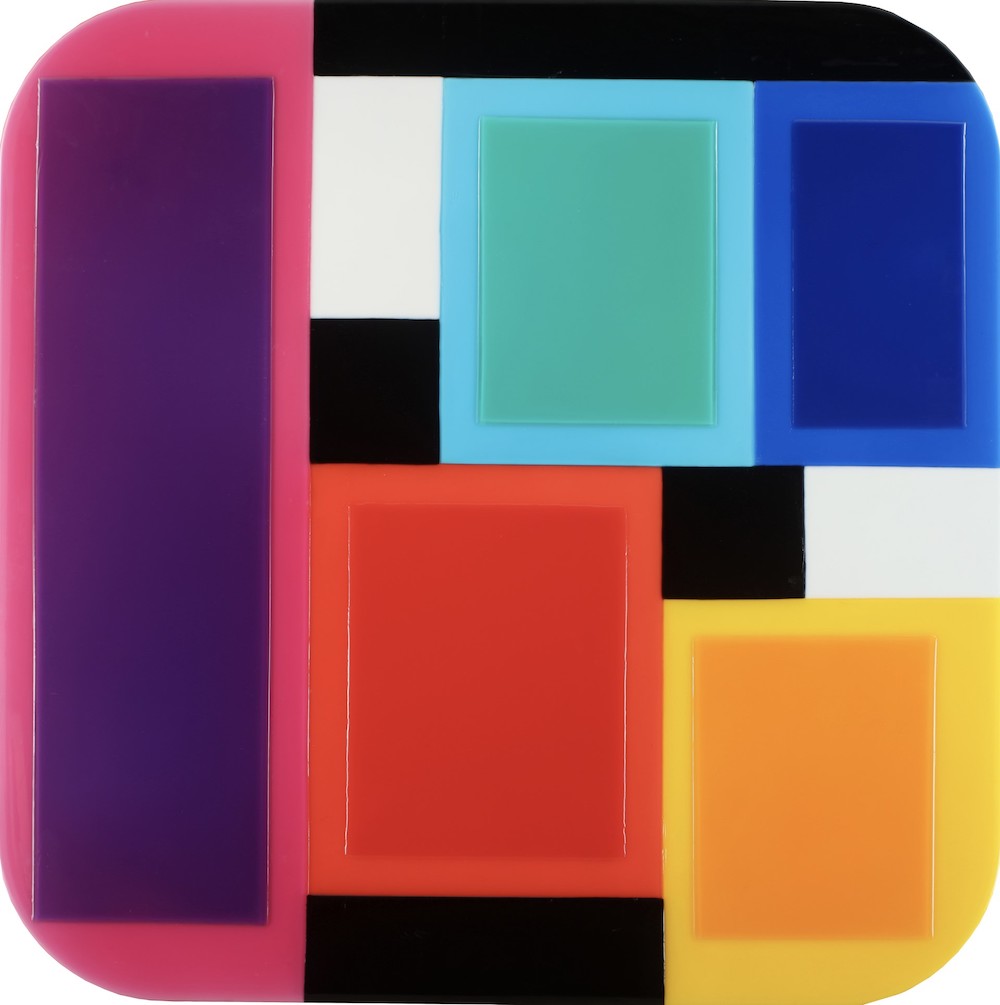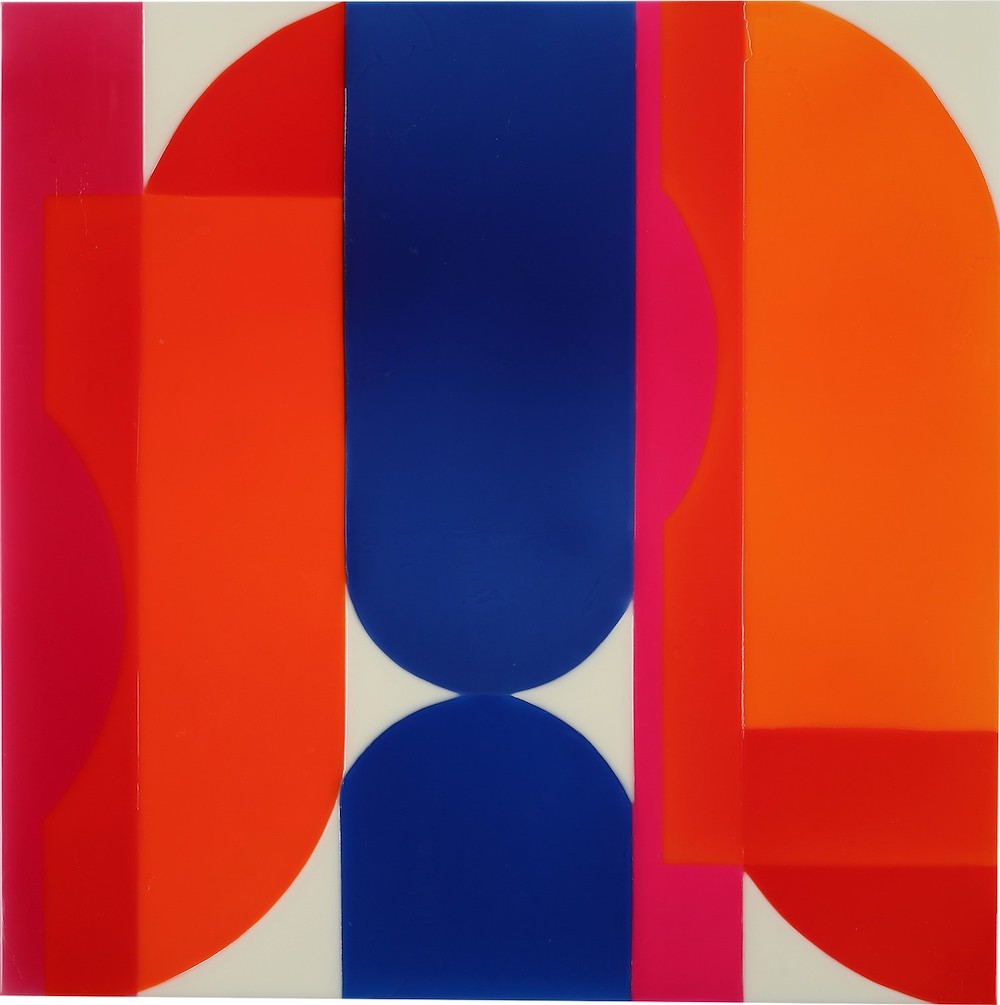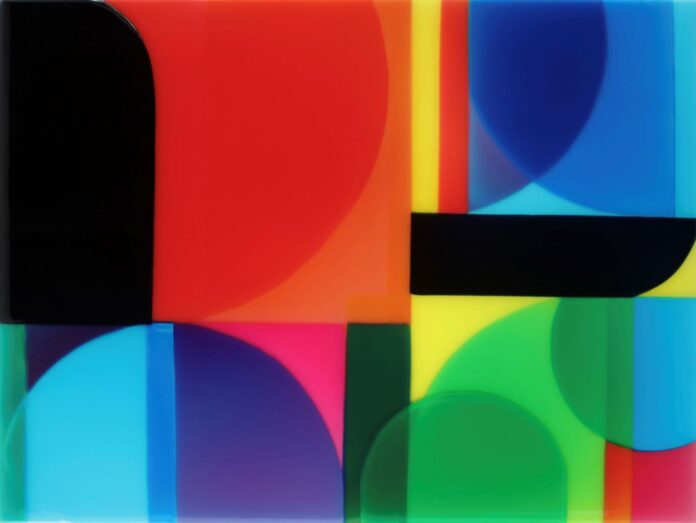>>We need you! Become a 48hills member today so we can keep up our incredible local news + culture coverage. Just $20 a month helps sustain us. Join us here.
The creative work of Lola is a dialogue between the artist and her materials. Working in manipulated tinted epoxy resin poured onto wood panels, she describes the forms that emerge in her process as characters in a play. They speak to her—and to each other—guiding her towards completion of each piece.
Born in Queens, New York, Lola grew up on Long Island. After graduating from Syracuse University (BFA, 1991) she attended The Culinary Institute of America and completed a bachelor’s degree in culinary arts in 1994. She moved to San Francisco after graduation, having accepted a job at the restaurant Aqua. For many years, she ran the successful Lola’s Café in San Francisco and began experimenting with assemblage and collage works from found objects.

“We live in a society that is based on consuming and throwing everything away. It is very disturbing to me. Making this work was a way to take these leftovers and transform them into something beautiful and meaningful,” Lola told 48hills.
During her career as a chef, the vibrancy of San Francisco provided inspiration and opened the door for her work to grow and thrive. Self-taught Lola’s work has been referred to as outsider art due to the fact that it is not created within the conventional boundaries of the industry.
“The Bay Area is overflowing with incredible artistic talent. The diversity is vast and greatly inspiring. I love attending Open Studios, it’s fun to meet the artists and talk one on one about their work. There is also a tremendous amount of support for emerging artists. In the beginning of my career, Art Span was an invaluable resource,” she said.
Lola has always been a collector of odds and ends like unique pieces of wood with interesting patterns, old metal parts, and other remnants. She would often ride her bike around the city, taking photographs of debris, abandoned buildings, scrap-metal, stacks of wood, and the like.

“When I was a kid, I had a shelf where I kept all kinds of found objects and little trinkets. Debris was magical for me! It makes sense that I would begin to create collage and assemblage,” she said.
While working in the restaurant industry, creative playtime off-set the stress of work. Inviting artists to show their work in her café, she eventually began to show her own work too, receiving generous feedback and support from the local community.
“The art on display at the restaurant, including my own, sold very well. So well that I suddenly realized there was something much bigger going on. Inside I heard a voice say, ‘You are going to be an artist.’ I knew that this was the truth. I sold the restaurant and devoted myself full time to making art,” Lola said.
The transition to her current work was serendipitous. During her first Burning Man, Lola assisted with a project that required the use of fiberglass resin. She fell in love with the material and began finishing her pieces with epoxy, later adding color into the process.
“I noticed these wonderful pours layered on my table. I used those random pieces to create new work,” she said.
As her career began to grow, she started to pour exclusively with tinted resin, saying goodbye to the days of assemblage and collage. Working with imagery that incorporated shapes, numbers, and letters, she says that people would always try to decode the elements in her work, believing that they contained some kind of hidden message or secret meaning that had to be deciphered to be grasped. Everything changed when she saw a Kandinsky retrospective in New York.
“Suddenly a light bulb went on and I understood that form and color could really carry the work. These two things, form and color, are really the basis of all my work now,” she said.
Using colored resin and peeling back the dried shapes, the numbers and letters soon disappeared from her work. Lola says she felt they were no longer necessary and, in fact, just got in people’s way of appreciating the forms.
A huge fan of painter Mark Rothko (1903-70), Lola is driven by color, and abstraction is an intuitive choice. She says that the genre comes naturally to her, that she appreciates its flow, and that unlike realism or figurative styles there aren’t any rules.
“When I start a piece, I pick one color and allow it to inspire where the piece will go and how the composition will evolve,” she said.

Lola learned a number of processes to control the resin, like wiping and feathering, mastering the flow and formation of shapes as they dried on a surface. Studying images of elements in nature, she observed a commonality with the shapes in her work.
“The process of working with resin is one that I am always refining. I am learning as I go. It’s a part of my love of experimenting with life and with nature. I ask, ‘What will happen next? How will I respond?’ It is in collaborating with the materials and what the materials are revealing to me that is most exciting,” she said.
She says that even without the recognizable symbols of her former work, people sometimes still look to break the code of her abstractions.
“It’s like someone asking, ‘Wait a minute. I think I see a chicken. Is that a chicken?’ No. There’s no chicken in my work. Please don’t go looking for a chicken,” Lola said.
Currently residing in the East Bay where she is raising her 13-year-old daughter as a single mom, Lola’s large artworks come to life in her garage studio. It’s an ample space that accommodates working on several pieces at once. She describes her studio as her safe place where she can go to escape the pressures of the outside world. By setting herself into a singular role with a specific task, she is there to create and allow things to unfold organically.
Each day begins with an initial pour of color onto wood panel, using both stock paints and custom mixes of various pigments. She then begins mapping out the composition, which often involves taping off areas to where she will pour a coat of resin.
“When balance and beauty is achieved, the work is complete,” Lola said.
To abide by safety practices within her work, Lola utilizes an industrial exhaust fan. And because resin will not cure correctly if the temperature is below 65 degrees, she uses infrared heaters.
Lola’s creations rotate between multi-layered, complex compositions and clean, color field pieces, with both approaches playing off each other to encourage a natural evolution into the next body of work. Over the past year, she has gravitated toward using wood panels that have been curved, bringing that structure into the composition. With regard to the geometric motif in some of her pieces, Lola says she began creating works with straight lines and right angles during the pandemic.
“Everything felt so out of control. Those compositions gave me a sense of control and grounded me. When things calmed down and life resumed a sense of normality, I felt the anxiety around the pandemic lifting. I could breathe again. That’s when I moved toward the more tranquil and calming color field work,” she said.

Lola’s work is represented and regularly exhibited by several galleries, including James Bacchi Contemporary, based in Palm Springs and San Francisco, and Ric Michel Fine Art in New York. Recent exhibitions include, Nothing is Going as Planned, but Everything is as it’s Supposed to Be, in July 2023 at GF Contemporary in Santa Fe, New Mexico. Her solo exhibition, First Pour, at Slate Contemporary in Oakland ran from November 2023 to January 2024.
In April, Lola participated in The Other Art Fair in Santa Monica, working with her new concept of curves, which was represented through the compositions alone, by shaped panels, or both. Coming up, she will be in the group exhibition, Four Squared 2024, at Arc Gallery & Studios in San Francisco from August 24 to September 28.
In the dialogue she has with her colors and materials, Lola says there is an unspoken language, one that she cannot hear but she can feel.
“The language has an emotional value that taps into a different part of the brain. The challenge is in leaving the emotion unidentified. With each artwork, my intent is to create an experience. I allow the viewer to think, feel, and find their unique significant meaning,” she said.
Lola thinks every artist hopes there will be people who take time to be reflective as they view an artist’s work. She doesn’t want people to think that her work is just pretty to look at, though she admits that she is glad when people find beauty there. When asked what she hopes people will ultimately experience from her work, Lola answered concisely, “Joy and tranquility.”
For more information, visit her website at lolasartwork.com and on Instagram.





